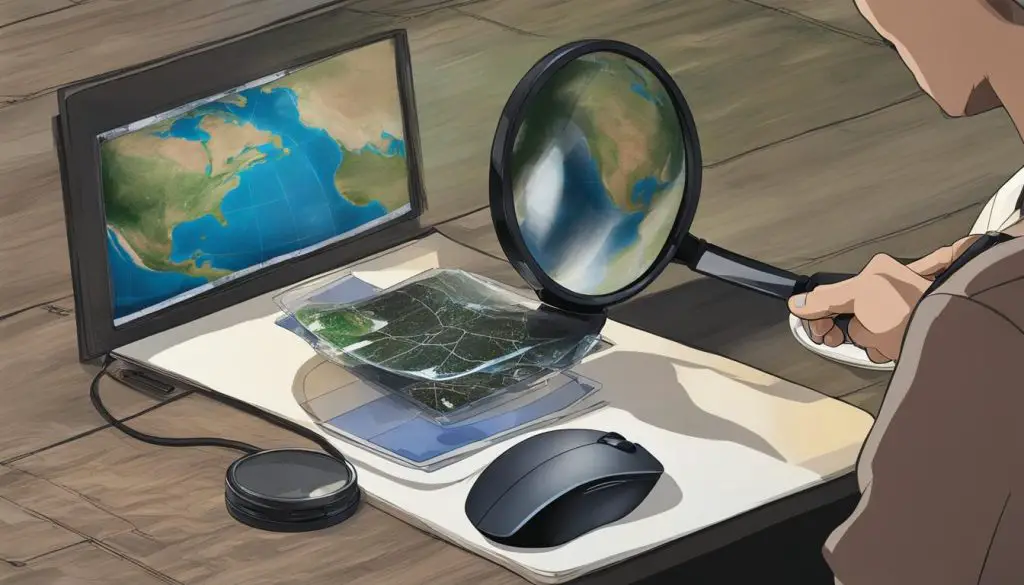Welcome to our comprehensive tutorial on using TIFF files from Earth Explorer. In this guide, we will walk you through the entire process, from creating an account to downloading and saving the files. Whether you’re a mapping enthusiast or a professional geospatial analyst, this guide will equip you with the knowledge and skills to effectively utilize TIFF files from Earth Explorer for your projects.
Earth Explorer is a powerful platform that provides access to a vast collection of high-quality geospatial data in TIFF format. By following the steps outlined in this guide, you’ll be able to harness the power of these files and create accurate and detailed maps for a wide range of applications.

Key Takeaways:
- Creating an account with USGS EROS Registration System (ERS) is the first step to accessing TIFF files from Earth Explorer.
- Use search criteria and data sets to narrow down your search and find the TIFF files that meet your mapping project requirements.
- Downloading TIFF files from Earth Explorer is easy, but you’ll need appropriate software to unzip them and access the files.
- With TIFF files from Earth Explorer, you can enhance the quality and precision of your mapping projects.
- Remember to specify your search criteria accurately to obtain the most relevant TIFF files for your projects.
Accessing Earth Explorer and Creating an Account
Before you can start using TIFF files from Earth Explorer, you need to access the Earth Explorer interface and create an account. Follow these steps to get started:
- Visit the Earth Explorer website at earthexplorer.usgs.gov.
- Click on the “Login/Register” button to navigate to the registration page.
- Once on the registration page, you will be directed to the USGS EROS Registration System (ERS) website. Fill out the required information and complete the registration process.
- After successfully creating an account, use your credentials to log in to Earth Explorer.
By creating an account with USGS EROS Registration System (ERS), you will gain access to Earth Explorer and be able to search for and download TIFF files for your mapping projects.
Why create an account?
Creating an account with USGS EROS Registration System (ERS) is essential for accessing Earth Explorer and its wide range of geospatial data. With an account, you can save your search criteria, access advanced features, and keep track of your downloaded files. Additionally, having an account allows you to receive updates and notifications about new datasets and any changes to the Earth Explorer interface.
Account security and confidentiality
Rest assured that the USGS EROS Registration System (ERS) takes your account security and confidentiality seriously. Your personal information will be stored securely and will not be shared with third parties without your consent. By following best practices such as choosing a strong password and keeping your login credentials private, you can further ensure the security of your account.
| Benefits of creating an account with USGS EROS Registration System (ERS) | How to create an account |
|---|---|
| Access to Earth Explorer and its extensive collection of TIFF files and geospatial data. | Visit ers.cr.usgs.gov/register and fill out the registration form. |
| Ability to save search criteria and track downloaded files for easier access in the future. | Provide the required information, including your name, email address, and desired username and password. |
| Receive updates and notifications about new datasets and changes to the Earth Explorer interface. | Confirm your registration by following the verification process sent to your email address. |
Searching and Selecting TIFF Files
To effectively use TIFF files from Earth Explorer, you need to know how to search for and select the right files for your mapping projects. Earth Explorer offers a variety of search criteria and data sets that can help you find the specific TIFF files you need.
When searching for TIFF files in Earth Explorer, it’s important to specify your area of interest, date range, and other relevant parameters. This will help narrow down the search results and ensure you find the most relevant files. For example, if you’re interested in a specific region or time period, you can enter the corresponding information in the search criteria.
Additionally, Earth Explorer allows you to select the specific data sets you want to include in your search. This can be helpful if you’re looking for a particular type of geospatial data, such as Landsat imagery or aerial photography. By selecting the appropriate data sets, you can further refine your search and find the TIFF files that best match your mapping project requirements.
Example: Searching Criteria for TIFF Files
Let’s say you’re working on a coastal mapping project and need high-resolution satellite imagery of a specific area. In Earth Explorer, you can set the search criteria to include only satellite data, specify the desired resolution and date range, and focus on the coastal region of interest. This will help you retrieve TIFF files that meet your project’s needs and provide the necessary level of detail for accurate mapping.
| Search Criteria | Setting |
|---|---|
| Data Sets | Satellite Imagery |
| Resolution | High (e.g., 1 meter) |
| Date Range | Specific period relevant to your project |
| Area of Interest | Coastal region (e.g., latitude and longitude coordinates) |
By utilizing the search criteria and data sets available in Earth Explorer, you can streamline your search process and find the TIFF files that best match your mapping project requirements. This will save you time and effort in selecting the right files for your analysis and mapping purposes.
Next, in Section 4, we will explore how to download and save the TIFF files you have selected from Earth Explorer.

Downloading and Saving TIFF Files
Once you have identified the TIFF files you want to use, downloading them from Earth Explorer is a straightforward process. Simply click on the download button next to the desired file, or utilize the bulk download option if you need multiple files. The selected TIFF files will be downloaded in a compressed format, such as .tar.gz, to minimize file size and facilitate faster downloads.
After the download is complete, you will need to unzip the compressed files using appropriate software. Most operating systems have built-in tools for file extraction, or you can use third-party software like WinRAR or 7-Zip. Once the files are extracted, you will have access to the TIFF files in their original format.
When saving the TIFF files, it’s important to consider the file format and data processing requirements. TIFF files are commonly used for geospatial data due to their ability to store high-resolution images and maintain data integrity. However, depending on the software or system you intend to use for data processing, you may need to convert the TIFF files into a compatible format. Popular file formats for geospatial data include GeoTIFF, which embeds geographic information within the file itself, and JPEG2000, which offers superior compression and image quality.
| File Format | Description |
|---|---|
| TIFF (.tif) | A widely supported format for storing geospatial data, allowing for high image quality and data integrity. |
| GeoTIFF (.geotiff, .tif) | An extension of the TIFF format that includes georeferencing information, enabling spatial referencing and analysis. |
| JPEG2000 (.jp2) | A highly efficient format that provides excellent compression while maintaining high image quality, suitable for large datasets. |
Once you have saved the TIFF files in the desired format, you can use them in various geographic information system (GIS) software for further analysis and mapping. Whether you are conducting spatial analysis, creating maps, or performing remote sensing tasks, the downloaded TIFF files from Earth Explorer will serve as valuable resources to enhance your projects.
Conclusion
Using TIFF files from Earth Explorer can greatly enhance your mapping projects by providing high-quality geospatial data. With the step-by-step guide outlined in this article, you now have a clear understanding of how to effectively utilize TIFF files from Earth Explorer.
Remember to accurately specify your search criteria to ensure you obtain the most relevant files for your mapping needs. Additionally, it is important to have the necessary software to process and utilize the TIFF files effectively, as they often come in compressed formats that require extraction.
By accessing Earth Explorer, searching for TIFF files using the available criteria and data sets, and then downloading and saving the files to your computer, you can harness the power of TIFF files for various mapping and analysis purposes.
Take your mapping projects to new heights with Earth Explorer and TIFF files, and unlock the potential for detailed and accurate geospatial mapping.
